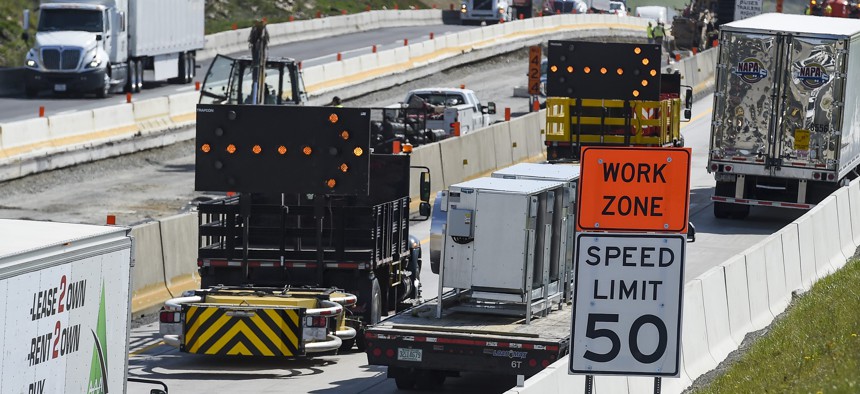One State Targets Teen Drivers to Reduce Work Zone Deaths

Ben Hasty/MediaNews Group/Reading Eagle via Getty Images
As traffic deaths surge, contractors are calling on states to do more. One state—Oklahoma—will be the first in the nation to require teen drivers to complete a course on construction worker safety.
To combat a national rise in worker deaths, Oklahoma this fall will require new teen drivers to complete a one-hour course online about work zone safety. It will be the first state in the country to do so.
The law is intended to deal with a problem many states are wrestling with: a surge in traffic deaths, including in work zones.
The number of people who died in work zone crashes increased from 586 people in 2010, to 956 people in 2021. Meanwhile, 55% of highway contractors in a national survey administered by the Associated General Contractors of America reported that they had a motor vehicle crash on one of their work sites last year.
A March crash in Baltimore that left six workers dead galvanized construction workers and their employers to call attention to the dangers of driving recklessly in construction zones. The drivers of the two cars that collided in the Baltimore crash were both speeding, according to a preliminary report by federal investigators.
With Americans starting to travel for summer vacations and construction crews coming up on their busiest season of the year, many contractors are pushing for policies to reduce injuries and death to both workers and drivers.
During a press call Thursday, contractors called for increased penalties and more enforcement of existing laws to keep work zones safe. They asked for more police to be stationed in work zones. They said police who are monitoring those areas should be allowed to pursue motorists who speed or drive recklessly; in some areas, police are not allowed to leave the work zone. And they called for wider deployment of traffic cameras in work zones to catch speeders.
While officials in many states consider those established methods, Oklahoma lawmakers voted this year to add the education requirement.
Contractors in Oklahoma wanted to do something different than just requiring a question on the driver’s exam to be about work zone safety, said Tom Robins, a consultant and former state energy official who developed a course for teens to learn about work zone dangers.
“We have flooded our roadways with digitally drunk drivers,” Robins said. “[Those drivers] are learning that behavior when they are young, and they’re bringing that behavior with them in the car. That travels with them either as a passenger or as a driver, and it's showing up in our work zones.”
The conventional methods of teaching teens about work zone safety weren’t working, Robins said. The new drivers would get “a plastic bag with a cartoon character on it about distraction, a plastic pen and a pamphlet with the legal definition of the state’s move-over and work-zone-safety laws,” he said during the press briefing Thursday. “Quite frankly, this wasn’t working.”
The education requirement in Oklahoma looks to drive the message home in a new way.
First, contractors and state officials set up mock work zones, complete with construction equipment, across the state where teen drivers could get practice driving through constrained lanes before they encountered them on the highway. Some 15,000 teens participated in one of 20 such events over the last year, according to Robins.
The basic message the contractors pushed was: “Eyes up, phone down, buckle up and slow down.”
“When you talk to teens, they’re scared. They want education. My rural teens will avoid urban environments with work zones. They’re white knuckling through there, and there is no requirement that they safely navigate through a work zone,” Robins said.
“The most important part of that experience was placing a face—or recognizing there’s a family—behind every flag,” he added. “The eyes were opened of these teens, as they met these workers, and as these workers walked them through a work zone and explained to them what they were seeing how they should respond.”
The second element was the online course, a format that would be comfortable to teens.
The free course developed by Robins talks about different elements of work zone safety—such as slowing down or pulling over for emergency vehicles—and described why they were important, using examples from Oklahoma. Students hear stories of other teens who lost loved ones because of work zone crashes. Test questions at the end ask about the details of the people who were killed and their families.
Teens who take the course are eligible for $500 scholarships.
Bobby Stem, the executive director of the Association of Oklahoma General Contractors, said the education measure was an easier sell than more enforcement-heavy approaches to work zone safety, such as speed cameras and hefty fines many drivers might not be able to pay.
Daniel C. Vock is a senior reporter for Route Fifty based in Washington, D.C.
NEXT STORY: Solving digital inequity with resident input






